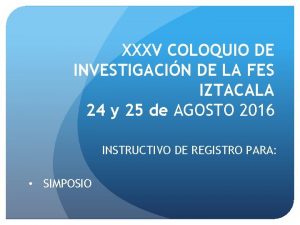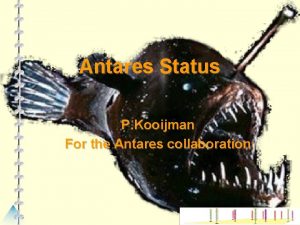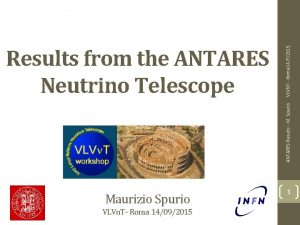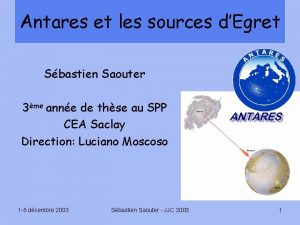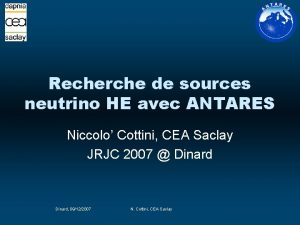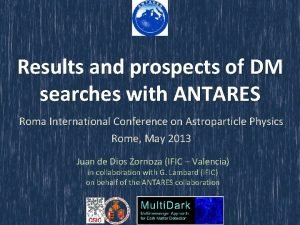Presentation of results for point sources in ANTARES


![3 First results from ANTARES 5 Line [ar. Xiv: 0909. 1262] All sky survey 3 First results from ANTARES 5 Line [ar. Xiv: 0909. 1262] All sky survey](https://slidetodoc.com/presentation_image_h/33dd3b5f73e68f6cd905f4c166dd1cae/image-3.jpg)







- Slides: 10

Presentation of results for point sources in ANTARES S. Toscano, UW Madison M. A. N. T. S. 2009

2 Unbinned vs. binned method Different methods have been developed within ANTARES collaboration for the search of point sources: • BINNED methods • UNBINNED methods Unbinned methods show better results: • by using a continuous variable as test statistic, instead of a discrete one, the (simple ‘Neyman’) 90%CL upper limits on the mean number of events improve by 30%, even if no extra information is used. [showed by A. Heijboer in ANTARES Internal Note] ANTARES Collaboration published results obtained with the EM method (unbinned). S. Toscano M. A. N. T. S. 2009 Berlin, Sep 26 2009
![3 First results from ANTARES 5 Line ar Xiv 0909 1262 All sky survey 3 First results from ANTARES 5 Line [ar. Xiv: 0909. 1262] All sky survey](https://slidetodoc.com/presentation_image_h/33dd3b5f73e68f6cd905f4c166dd1cae/image-3.jpg)
3 First results from ANTARES 5 Line [ar. Xiv: 0909. 1262] All sky survey Source list search p-value = 0. 3 (1 s excess) (d = -63. 7º RA =243. 9º) S. Toscano M. A. N. T. S. 2009 Berlin, Sep 26 2009

4 The EM algorithm Well-known in ANTARES and already presented in Ice. Cube (see Juanan’s talk in last Spring meeting) The EM algorithm is a well-known algorithm used in clustering analysis. The likelihood maximization procedure is achieved analytically for finite mixture problems, in which the total pdf is described by different density components. Point-like sources 5(3 for source fixed) parameters to estimate the Gaussian widths are left as free parameters S. Toscano M. A. N. T. S. 2009 Berlin, Sep 26 2009

5 The EM method as applied in ANTARES [J. A. Aguilar & J. J Hernández. Astroparticle Physics, Volume 29, Issue 2, p. 117 -124] The EM clustering algorithm as used in ANTARES for the unbinned point-source analysis: Pre-clustering algorithm: only few candidate clusters are considered 1. 25º Initial values Y(0): -m cluster barycenter -s cluster size -p. S cluster elements EM Algorithm Test statistics: BIC S. Toscano M. A. N. T. S. 2009 Berlin, Sep 26 2009

6 BIC distribution In the case of two model testing (only-background, M 0, and background+signal, M 1) is given by: Likelihood ratio penalty BIC distribution for 104 only-background and different signal events added. Bg-like Signal-like δ=-80º A fit of χ2 to the tail of the BIC distribution for the only-background is extrapolated to reach the 5σ confidence level. Only the highest BIC value for each sample is used to create the distribution: 104 exp. -> 104 BIC values BICth(3σ) BICth(5σ) S. Toscano M. A. N. T. S. 2009 Berlin, Sep 26 2009

7 d. P/d(BIC) P-value and upper limits (Neyman) background source 90% The P-value is the probability of the background to produce the measured (or higher) observable (BIC): • only background needed; • normally expressed in number of s (double side). When no significant excess is found in the data upper limits can be computed for a given confidence level (C. L. ): 10% BICobs Probability of this BICobs is not coming from a source Sensitivity: BICobs is the median of the background-only distribution. S. Toscano M. A. N. T. S. 2009 Berlin, Sep 26 2009

8 ANTARES-5 Line PS analysis Ice. Cube PS analysis Search performed in all sky by looking at the most significant clusters: Search performed in all sky fixing the position (step 0. 1°x 0. 1°): 1. A pre-clustering algorithm selects few clusters candidates in all sky. The EM algorithm run only for these clusters. 2. BIC background distribution simulated (104 experiments). The method gives the post-trial significance of the hottest spot in the sky. 1. Algorithm runs for each fixed position. Significance computed in each point of the sky. 2. Pre-trial significance is calculated using χ2 distributions (significance map). Post-trial computed only for the hot spot by scrambling significance maps. ANTARES implementation is fast to produce all-sky discovery potentials (posttrial) but no significance map is provided. S. Toscano M. A. N. T. S. 2009 Berlin, Sep 26 2009

9 Comparison with the MLR used for IC 22 [Juanan’s talk in last Spring meeting] • Sensitivity E-2 (90% C. L) • Discovery potential @ 5σ (50%) There is about a 10 -20% of penalty mainly for the extra degrees of freedoms and a difference in the way in which upper limits are computed. S. Toscano M. A. N. T. S. 2009 Berlin, Sep 26 2009

10 Conclusions • ANTARES results for PS analysis are obtained using an unbinned analysis based on the EM algorithm. • Background distribution is simulated. A χ2 fit of the tail used to extrapolate to 5 s. • Discovery potential fluxes in ANTARES are normally provided for all-sky, while sensitivities are calculated in source by source basis. • Significance given in number of standard deviation σ (double side). • Upper flux limits computed using the Neyman approach for a differential E-2 neutrino flux. (Integral flux easily calculated using the low energy threshold). S. Toscano M. A. N. T. S. 2009 Berlin, Sep 26 2009


